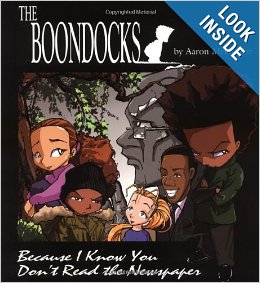
Character: Jazmine Dubois
Source Text: McGruder, Aaron. Boondocks: Because I Know You Don’t Read Yhe Newspaper
Entry Author: David Lwamugira
Aaron McGruder’s highly intelligent and racially charged comic strip, the Boondocks, provides readers some insight into the thinking of a pair of African American youths named, Huey and Riley, who must navigate their way through a mostly white society. The neighbor of these characters , Jazmine, acts a literal bridge between the two worlds because she has a black father and a white mother. During Jazmine’s first interaction with Huey, Huey tells her, much to her despair, that “it’s good to have more black people around.” Jazmine disputes the fact she is black and asks Huey why he would assume what race she was. Huey responds by saying, “Well first of all, Mariah, your afro is bigger than mine.” When she responds with, “I don’t have an afro – my hair is just a little frizzy today,” Huey retorts: “Angela Davis’ hair was ‘a little frizzy.’ you have an afro.” Jazmine then screams in protest, “I DO NOT and who is Angela Davis?” Huey compares Jazmine to Angela Davis, an African American political activist who took part in the Civil Rights movement and she fails to catch the reference. This shows that Jazmine has the physical appearance of an African American but does not fully identify herself as a member of the community, as well as the gap in historical knowledge between Huey, an African American, and Jazmine, a member of both the White and African American communities.
Jazmine’s identity is constantly being determined by others. When asked by a school questionnaire what race or ethnicity Jazmine belongs to, Jazmine leaves the field blank. The elementary school principal calls Jazmine’s mother in order to get a straight answer and she says it’s up to Jazmine to construct her own identity: “We don’t want anyone doing that for her. Is that clear? If she must be called anything, use the term ‘multiracial.’ Never ‘white,’ never ‘black.’ Ok?” Immediately after this speech, the principal decides to ignore her mother’s advice and identify Jazmine as an African American. So many people in this world ignore the fact Jazmine is a mixture of races. By defining her as one or the other, they limit her growth as a person.
In a moment of desperation, Jazmine expresses her feelings in a very open and honest manner that captures the experience of being biracial:Most people don’t understand what its like being different. Like…I once saw a yellow flower right in the middle of a bunch of red roses…everything around it was either green or red, and here was this yellow flower. It looked lonely. That’s what it’s like being biracial. I’m different from everyone else. My mom and dad say that makes me special, but i just think it’s lonely. (McGruder 27)
Her soliloquy shows the reader she is just a young girl trying to find acceptance in a world where defining someone’s race can still mean defining their character. Jazmine wants to live her life free of judgment or the pressure to choose which race she shall identify with. Yet the notion of belonging to one race or another matters much more to her peers than it does to her. Like any human being, Jazmine wants to be treated with decency and respect.
